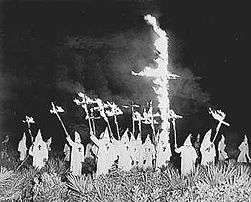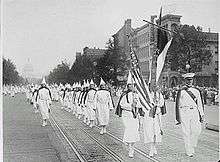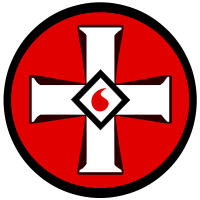Ku Klux Klan regalia and insignia

The costume of the Ku Klux Klan (sometimes known as the "glory suit" by Klansmen) is perhaps the most distinctive feature of the Ku Klux Klan, and is recognized worldwide. The archetypal outfit was actually popularized largely during the revival of the Klan from 1915 to 1944 and consists of: a floor-length, solid-white robe (often decorated with a round badge bearing an insignia with a cross) and a white, sharply pointed hat that includes a full-faced cloth mask with eyeholes. The basic costume, which has some rank-based and regional variations, is designed deliberately both to disguise its wearer's identity and to give the wearer an intimidating appearance.
Development


The origins of the use of the costume are unclear. Such garments have been traditionally used at least from the 15th century in festivities such as Holy Week, symbolizing the act of penance.[1] In Spain and its former territories, which included parts of the United States, the pointed hat is called "capirote". It is unrelated to the KKK except by its superficial resemblance.
The film The Birth of a Nation has been suggested as the model that stimulated adoption of elements of certain dress and regalia by the second KKK (founded in 1915). However, the film shows the Klansmen wearing a variety of costumes, and there is far less 'standardization'. For example, rather than the well-known conical hats, the film shows a number of Klansmen in what are effectively 'flat' hoods, with a pole sticking up, as if to resemble medieval armor.[2]
Robes of the 19th-century KKK were of various colors. In the 20th century, the second KKK adopted white as the standard color. Late 20th-century manifestations of the KKK in small groups has meant a wider variation in robes. Some groups use colored robes for higher ranks.
Some klans use all-white robes regardless of rank. For those that use robes of different colors most use:
- Purple (or sometimes blue) – Imperial Wizard
- Green (or sometimes red) – Grand Dragon
- Reddish-purple – Great Titan
- Gold - Exalted Cyclops
- Black – Knighthawk (security)
- Red – Kleagle
The Knighthawk's black robe is usually shorter so as to allow easier movement.
Insignia
The insignias of the Klan often include a cross, sometimes with a drop of red blood in the center.
M.I.O.A.K. (Mystic Insignia Of A Klansman) is a red, round patch worn over the left breast of a Klansmans robe. It has a large "X" in the middle with a "K" in each corner of the "X" for Knights of the Ku Klux Klan. The symbolism behind the insignia, according to various KKK groups, is that the blood drop in the center of the cross represents the blood shed by Jesus Christ at the Crucifixion, for the white Aryan race, whom they see as God's master race or chosen people.

Present day
The current organization has splintered, but a number of successor organizations use what is effectively similar costume. The major factions currently include the Imperial Klans of America, The Louisiana White Knights, The loyal white knights, The traditionalist American knights and the Knights of the White Camellia
Popular culture
The Ku Klux Klan costume has appeared in several modern day cultural references, some comical and others slightly more serious. Examples include:
- In "Pinkeye", an episode of South Park Eric Cartman appears to be dressed as a Klansman for Halloween when his principal makes a ghost costume with a pointed hood.
- The mini-series Roots contains a scene where a Confederate veteran is shown inventing an early KKK robe by accidentally burning two holes in a cloth sack with a cigar.
- The film Blazing Saddles features Cleavon Little, the sheriff, and Gene Wilder, a gunslinger, posing as Klansmen in order to join the gang of villain Hedley Lamar. The joke is that Little is black, and Wilder is Jewish.
- The MAD Magazine issue #207 sposter comedy National Lampoon's Animal House contained a line where characters compared toga parties to KKK rallies,[3] which fired an angry letter from the Klan appearing in issue #209.[4] In response, John Landis and John Belushi wrote their own letter praising the magazine, claiming "It is an honor to be associated with any insult to the Klan."[5]
- The film O Brother, Where Art Thou? contains a scene at a KKK rally.
- Playwright Larry Shue's 1983 comedy The Foreigner revolves around Charlie, a shy Englishman, and his accidental discovery of a plot by local Klansmen to appropriate a young woman's inheritance money to fund their endeavors.
- In the opening sequence of Alan Ball's True Blood there is a shot of a small boy in the robes of the Klan standing amongst adults in the same attire.
- The film Fried Green Tomatoes contains scenes of KKK members, including one of Frank when he comes by to see his son.
- The Heavy Weather story arc in the sixth part of the manga series JoJo's Bizarre Adventure, Stone Ocean tells the story of the character Weather Report, who—because of his late adoptive father's black heritage—is hung by KKK members, but survives.
References
- ↑ Gómez-Ruiz, Raúl. 2007. Mozarabs, Hispanics, and the Cross. Maryknoll, N.Y.: Orbis Books. ISBN 9781570757334.
- ↑ Birth of a Nation (poster on the Internet Movie Database image gallery) Archived March 1, 2009, at the Wayback Machine.
- ↑ MAD Magazine Issue #207; June 1979; "Abominable House" Page 8
- ↑ MAD Magazine Issue #209; September 1979; "Letters Department" Page 2
- ↑ MAD Magazine Issue #211; December 1979; "Letters Department" Page 2
External links
- Midnight Rangers: Costume and Performance in the Reconstruction-Era Ku Klux Klan
- Catalogue of offical [sic] robes and banners official Klan catalog